As Vikram Sharma drives his new Tata Nexon through the bustling streets of Mumbai, the afternoon sun gleams off its signature chrome strip, which curves elegantly across the SUV’s front. After spending fifteen years behind the wheel of Japanese and Korean vehicles, this marketing executive’s choice to switch to an Indian brand highlights a significant shift in how consumers view homegrown companies.
The Tata Nexon is more than just a vehicle; it represents Tata Motors’ metamorphosis from a brand concentrated on affordability to one that prioritizes cutting-edge design. When it first hit the market, the Nexon’s bold, coupe-like silhouette and unique features turned heads. Many industry analysts initially doubted that Indian consumers would favor such daring aesthetics over the traditional, more utilitarian designs typically associated with Indian automakers.
However, these initial reservations faded as the Nexon consistently soared in sales, eventually securing its spot as India’s favorite compact SUV for several quarters.
The recent redesign emphasizes these eye-catching features while refining overall proportions and detailing. The floating roof design, accentuated by contrasting top colors, contributes to a sense of lightness, while the pronounced wheel arches give the vehicle a grounded appearance.
Quality is another area where the latest iterations have impressed. Panel alignment and paint quality now rival those found in premium models, thanks to substantial investment in Tata’s Pune factory, which employs advanced robotics for crucial alignment tasks.
When it comes to performance, the Nexon’s engine options reflect a pragmatic approach. Instead of chasing high power figures, Tata has prioritized drivability and fuel efficiency with its 1.2-liter turbocharged petrol and 1.5-liter diesel engines—features that are essential for daily commuting.
The three-cylinder petrol engine, known for often being rough, has been meticulously engineered to provide smooth performance from idle through high RPMs thanks to effective balancing and mounting techniques.
While the 120 horsepower output may appear modest when compared to rivals, its consistent torque curve makes for lively driving, especially in the stop-and-go context of city driving.
Tata understands customer preferences, evident in the various transmission options: traditional manual, automated manual transmission (AMT), and dual-clutch automatic. The AMT, in particular, is favored by first-time automatic car buyers for its balance of affordability and decent shift quality.
One of the Nexon’s standout features lies in its commitment to safety. While many manufacturers add safety features as an afterthought, Tata has made occupant protection a fundamental aspect of its brand identity. The Nexon boasts the first five-star Global NCAP rating in India, leading other brands to rethink their structural integrity and safety equipment standards.
Recent models continue to build on this safety legacy, offering six airbags in most variants, electronic stability control, hill-hold assist, and ISOFIX child seat anchors. The high-strength steel used in the passenger cabin is strategically placed to absorb crash energy, all while keeping weight manageable.
This safety-first philosophy particularly appeals to family-oriented buyers, who are increasingly prioritizing security over a sheer number of features. Sales figures indicate a higher conversion rate among families with children, underscoring the effectiveness of Tata’s safety-focused messaging.
The latest Nexon also showcases Tata’s progressive approach to technology:
The 10.25-inch infotainment system offers wireless smartphone connectivity, accommodating major mobile systems without the hassle of wires. Its voice command feature employs natural language processing, allowing for a more conversational interaction.
The digital instrument cluster caters to different driving styles by providing customizable display settings. Additionally, connected car technology allows for remote vehicle monitoring, geofencing, and service alerts via a dedicated smartphone app.
Tata’s technology integration aims to simplify user experiences rather than overwhelm them, showing an understanding of consumer needs that extends beyond mere specifications.
The significance of the Nexon goes deeper than just sales numbers:
It has proven that Indian brands can compete on the design front, not just on price. The success of the Nexon has inspired Tata to pursue bolder designs across its lineup, while also prompting a widespread reassessment of safety and structural design among competitors.
Most importantly, the Nexon has altered how consumers perceive domestic car manufacturers, making them more open to considering Indian brands alongside their international counterparts. This shift in market perception not only benefits Tata but also strengthens the overall Indian automotive landscape.
Tata’s dedication to improving the ownership experience is clear through a variety of Nexon-specific initiatives:
For petrol engines, service intervals extend to 15,000 kilometers, lessening the need for frequent maintenance. Higher trims now come standard with a 5-year/100,000-kilometer warranty, allaying fears about long-term reliability. Furthermore, the roadside assistance program supports the vehicle throughout the warranty, no matter where it is located within India’s expansive territory.
These initiatives tackle historical issues that used to drive consumers towards established international brands, despite the difference in costs.
Tata Nexon
The Tata Nexon serves as a prime example of how targeted product development that meets market demands can reshape both the success of a model and the overall perception of a brand. By focusing on safety features, distinct design, and practical technology, while still offering tremendous value, Tata has crafted a compelling offering that stands out against established competitors based solely on merit.
For Indian car buyers, the Nexon is more than just a means of transportation—it embodies the ability of the domestic industry to produce world-class offerings through dedicated innovation and effort. As the compact SUV segment evolves, the Nexon’s impact on consumer expectations and competitor strategies will continue to resonate well beyond its impressive sales numbers.
